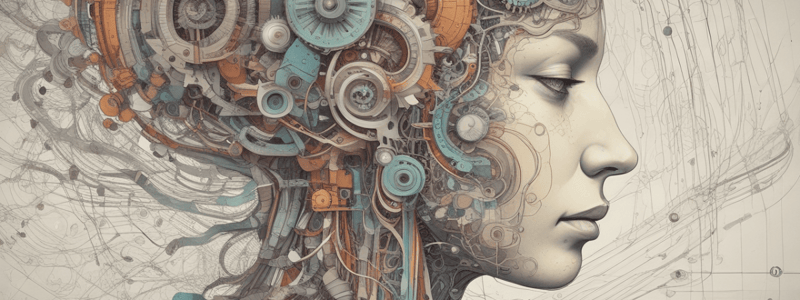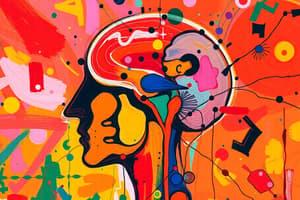Podcast
Questions and Answers
What role does the posterior parietal association cortex (PPAC) primarily serve in motor control?
What role does the posterior parietal association cortex (PPAC) primarily serve in motor control?
- It directly initiates muscle contractions.
- It processes auditory information only.
- It integrates spatial information and directs attention before movement. (correct)
- It is solely responsible for visual processing.
Which area of the brain receives input from the PPAC and is involved in deciding whether to initiate a voluntary movement?
Which area of the brain receives input from the PPAC and is involved in deciding whether to initiate a voluntary movement?
- The secondary motor cortex.
- The dorsolateral prefrontal cortex. (correct)
- The primary motor cortex.
- The visual cortex.
The secondary motor cortex is responsible for which of the following functions?
The secondary motor cortex is responsible for which of the following functions?
- Programming specific muscle contractions needed for movement. (correct)
- Deciding the intention to move before activation.
- Integrating sensory information from external stimuli only.
- Guiding visual attention during movement.
How does the sensorimotor cortex utilize multisensory integration?
How does the sensorimotor cortex utilize multisensory integration?
What is the relationship between the PPAC and the motor center of the cerebral cortex?
What is the relationship between the PPAC and the motor center of the cerebral cortex?
What distinguishes the role of the frontal eye field in sensorimotor systems?
What distinguishes the role of the frontal eye field in sensorimotor systems?
What is the primary function of the primary motor cortex (M1)?
What is the primary function of the primary motor cortex (M1)?
Which area is involved in the timing of movements and motor learning?
Which area is involved in the timing of movements and motor learning?
What characterizes the role of the basal ganglia in motor function?
What characterizes the role of the basal ganglia in motor function?
How does individual neuron target coding function within the motor system?
How does individual neuron target coding function within the motor system?
Which of the following accurately describes the overlap in motor areas?
Which of the following accurately describes the overlap in motor areas?
What is a major role of the cerebellum in motor control?
What is a major role of the cerebellum in motor control?
What is the primary output function of the primary motor cortex?
What is the primary output function of the primary motor cortex?
Which brain structure does not significantly contribute fibers down the motor pathways?
Which brain structure does not significantly contribute fibers down the motor pathways?
What is the main goal of the cerebellum in relation to movement?
What is the main goal of the cerebellum in relation to movement?
What type of coding do individual neurons in the primary motor cortex utilize?
What type of coding do individual neurons in the primary motor cortex utilize?
What characterizes the primary motor cortex (M1)?
What characterizes the primary motor cortex (M1)?
Which structure is primarily responsible for correcting ongoing movements that deviate from their intended course?
Which structure is primarily responsible for correcting ongoing movements that deviate from their intended course?
What is the primary role of the basal ganglia in relation to motor function?
What is the primary role of the basal ganglia in relation to motor function?
Which area is involved in both the activation of muscles and the planning of complex movements?
Which area is involved in both the activation of muscles and the planning of complex movements?
Which of the following statements about the primary motor cortex (M1) is true?
Which of the following statements about the primary motor cortex (M1) is true?
What type of signals does the cerebellum process to facilitate motor learning?
What type of signals does the cerebellum process to facilitate motor learning?
What type of information does the posterior parietal association cortex (PPAC) integrate for spatial awareness?
What type of information does the posterior parietal association cortex (PPAC) integrate for spatial awareness?
Which area of the brain is involved in the detailed programming of muscle contractions based on instructions from the dorsolateral prefrontal cortex?
Which area of the brain is involved in the detailed programming of muscle contractions based on instructions from the dorsolateral prefrontal cortex?
What is primarily assessed by the neural activity in the posterior parietal association cortex (PPAC)?
What is primarily assessed by the neural activity in the posterior parietal association cortex (PPAC)?
Which function is NOT attributed to the dorsolateral prefrontal cortex in motor control?
Which function is NOT attributed to the dorsolateral prefrontal cortex in motor control?
What kind of input does the secondary motor cortex primarily receive?
What kind of input does the secondary motor cortex primarily receive?
What is the primary role of the frontal eye field in the sensorimotor systems?
What is the primary role of the frontal eye field in the sensorimotor systems?
Flashcards are hidden until you start studying
Study Notes
Sensorimotor Systems Overview
- Involves structures and pathways that control and regulate movement and coordination.
- Key components include the sensorimotor cortex, cerebellum, and basal ganglia.
Sensorimotor Cortex
- Composed of posterior parietal association cortex (PPAC), secondary motor cortex, and primary motor cortex (M1).
Posterior Parietal Association Cortex (PPAC)
- Integrates spatial information and directs attention for movement.
- Utilizes multisensory integration from visual, auditory, and somatosensory systems.
- Neuronal activity reflects planning and intention to move limbs.
- Guides head, eyes, arms, and hands movements.
- Projects to the dorsolateral prefrontal cortex, which decides on initiating voluntary movement.
Secondary Motor Cortex
- Receives information from association cortices and relays to the primary motor cortex.
- Programs specific muscle contractions for movement based on input from the dorsolateral prefrontal cortex.
- Electrical stimulation produces complex bilateral movements.
- Neurons activate prior to voluntary movement initiation and remain active during movement.
- Composed of supplementary motor area, premotor area, and other regions.
Primary Motor Cortex (M1)
- Located in the precentral gyrus and receives input from the secondary motor cortex.
- Controls muscle activation by sending signals from the brain through the spinal cord.
- Major site for initiating complex, coordinated movements involving multiple muscles.
- Exhibits overlapping regions for different body parts, where one motor site can influence another.
- Neurons utilize target coding, moving limbs towards specific target locations.
Cerebellum
- Subcortical structure crucial for motor learning, especially in timing sequences of movement.
- Involved in the inhibition and activation of muscles, with a focus on timing.
- Receives signals from primary and secondary motor cortex, brainstem, vestibular systems, and sensory feedback.
- Compares and corrects ongoing movements to align with intended actions.
Basal Ganglia
- Subcortical structure interconnected with cortical areas and cerebellum, forming neural loops.
- Primarily modulates motor output rather than directly contributing fibers to motor pathways.
- Engaged in habit learning, cognitive functions, and refinement of motor actions through trial and feedback.
Sensorimotor Systems Overview
- Involves structures and pathways that control and regulate movement and coordination.
- Key components include the sensorimotor cortex, cerebellum, and basal ganglia.
Sensorimotor Cortex
- Composed of posterior parietal association cortex (PPAC), secondary motor cortex, and primary motor cortex (M1).
Posterior Parietal Association Cortex (PPAC)
- Integrates spatial information and directs attention for movement.
- Utilizes multisensory integration from visual, auditory, and somatosensory systems.
- Neuronal activity reflects planning and intention to move limbs.
- Guides head, eyes, arms, and hands movements.
- Projects to the dorsolateral prefrontal cortex, which decides on initiating voluntary movement.
Secondary Motor Cortex
- Receives information from association cortices and relays to the primary motor cortex.
- Programs specific muscle contractions for movement based on input from the dorsolateral prefrontal cortex.
- Electrical stimulation produces complex bilateral movements.
- Neurons activate prior to voluntary movement initiation and remain active during movement.
- Composed of supplementary motor area, premotor area, and other regions.
Primary Motor Cortex (M1)
- Located in the precentral gyrus and receives input from the secondary motor cortex.
- Controls muscle activation by sending signals from the brain through the spinal cord.
- Major site for initiating complex, coordinated movements involving multiple muscles.
- Exhibits overlapping regions for different body parts, where one motor site can influence another.
- Neurons utilize target coding, moving limbs towards specific target locations.
Cerebellum
- Subcortical structure crucial for motor learning, especially in timing sequences of movement.
- Involved in the inhibition and activation of muscles, with a focus on timing.
- Receives signals from primary and secondary motor cortex, brainstem, vestibular systems, and sensory feedback.
- Compares and corrects ongoing movements to align with intended actions.
Basal Ganglia
- Subcortical structure interconnected with cortical areas and cerebellum, forming neural loops.
- Primarily modulates motor output rather than directly contributing fibers to motor pathways.
- Engaged in habit learning, cognitive functions, and refinement of motor actions through trial and feedback.
Studying That Suits You
Use AI to generate personalized quizzes and flashcards to suit your learning preferences.




